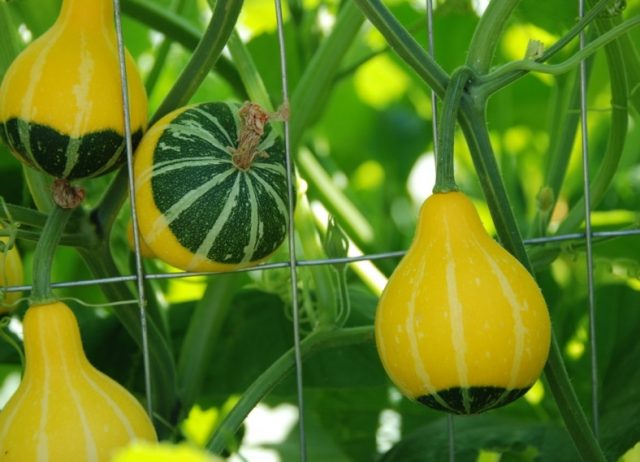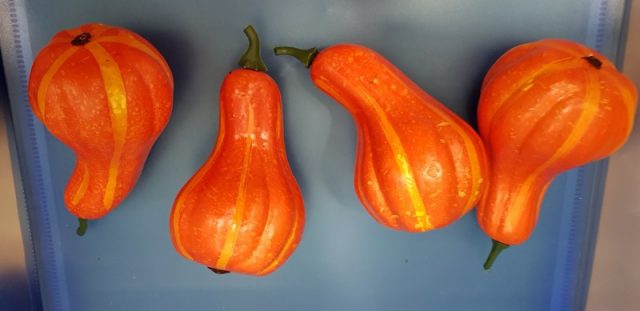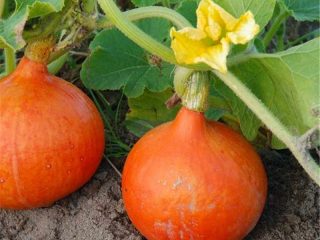Content
Climbing plants are often used to decorate buildings and other objects in personal plots. Various types of vines, ivy, wild roses and grapes have long taken their place in the designs of private houses and cottages. A special place among such plants is occupied by the climbing decorative pumpkin in the shape of a pear. It can decorate facades and hedges for a very long time - from June to November. In addition, the climbing pumpkin does not lose its decorative value in the fall, since fading leaves are replaced by beautiful fruits of unusual shape.
Description of decorative pear-shaped pumpkin
There are a large number of varieties of decorative climbing pumpkins, differing slightly in the appearance of the green part. The main external differences between these varieties relate to the appearance of the fruits, their quantity and ripening time.
Decorative pumpkin is a vine with a fast growth rate. This pumpkin is capable of producing shoots up to 6 m long. The height to which the shoots can rise is about 2 m.This plant is a perennial, but in the Russian climate it is cultivated as an annual.
Unlike most pumpkins, climbing varieties have thin (no more than 10 mm in diameter) stems. The number of stems is also large: if in ordinary pumpkins their number is limited to 4-5, then in decorative ones, due to frequent branching, their number exceeds a dozen. The tendrils, with which the stems cling to obstacles, are much better developed than those of an ordinary pumpkin. They have an increased growth rate and greater strength.
The leaves of these varieties are rarely more than 10-12 cm in diameter. Their color can vary significantly depending on the variety; there are both light green and rich dark green shades. The leaves are relatively thin, the pubescence is weakly expressed.
The flowers are almost always white, 5-6 cm in diameter. In rare cases, they can be yellow or orange. Their shape is standard for a pumpkin - a five-blade bell.
Description of fruits
A characteristic feature of the decorative pear-shaped pumpkin breed is the shape of its fruit, which, in fact, follows from the name. However, it should immediately be said that the color, the number of fruits on the plant, and the characteristics of their shape depend on the specific variety or hybrid of the plant. And the number of such varieties reaches several dozen.
Each plant produces 20 to 30 fruits. The flesh of these fruits is almost always light orange or yellow. The weight of the fruit lies within several tens of grams.
The color of the fruit is:
- yellow;
- white;
- red;
- creamy;
- orange, etc.
Spotted or striped varieties are often found. The skin of the fruit can be smooth, pimply, segmented, etc. A typical type of fruit of a climbing decorative pumpkin in the shape of a pear is shown in the photo:
The pear-shaped fruit shape common to all varieties can have different proportions. There are fruits with an elongated thin part (Cobra variety), a star-shaped thick part (Crown variety), a turban-shaped fruit (Turkish Turban variety), a segmented thick part (Sweet Dumping variety), and so on. The varieties closest to the classic pear-shaped form are the varieties of the Bottle Lagenaria group.
A large number of varieties have fruits with a curved shape of the thin part (Native Couture, Swan Neck, Peanut Butter and others).
The main purpose of the fruit is to decorate the site. In addition, ripe fruits are used to prepare various hand-made crafts (vases, lamps, candlesticks, flasks, etc.). The taste of such pumpkins is very mediocre.
Is it possible to eat decorative pear-shaped pumpkin?
Most varieties of pear-shaped decorative pumpkin are not suitable for consumption. Only a few of them can be used as raw materials for preparing pumpkin dishes. These include, for example, the Baby Boo or Peanut varieties.
Some varieties (for example, Sweet Dumping) can be eaten while they are not yet fully ripe, since when ripe their flesh hardens and they become unsuitable for food.
Main characteristics
The plant is decorative, so the concept of productivity does not apply to it.Most fruits are small in size and weight (from 10 to 50 g); in rare cases, large-fruited varieties are found, for example, Orange, weighing up to 300 g. However, as noted earlier, the vast majority of varieties are not suitable for food.
The plant has low frost resistance. During significant cold snaps, when the temperature drops below + 10-12 °C, shoot growth stops and does not resume.
Possessing an extensive horse system, the decorative pumpkin can go without water for a relatively long time. The plant will not die, but at the same time the growth rate of the green part is significantly reduced and the process of fruit formation slows down. In general, pumpkin loves abundant watering; it is not recommended to expose it to drought for too long.
Resistance to pests and diseases
Like any other member of the pumpkin family, the decorative climbing pear has average resistance to diseases and pests. The risk of being attacked by certain diseases and pests depends, first of all, on proper agricultural technology and plant care.
Among the diseases, the most common are powdery mildew and various types of rot (gray, root, etc.), as well as bacteriosis. Pests are also typical for pumpkins: melon aphids and spider mites.
Methods for controlling diseases and pests are standard. Fungal diseases are treated with solutions of copper sulfate (1% to 3%) or colloidal sulfur preparations. Acaricides or folk remedies (tincture of onion and garlic peels) are used against pests.
As a preventive measure, it is recommended to spray the foliage several times with a 1% solution of copper sulfate every 2 weeks, carried out in June-July.
Advantages and disadvantages
The plant has the following advantages:
- simplicity of agricultural technology and unpretentiousness in cultivation;
- a wide variety of colors and shapes of fruits and leaves, making it possible to realize any design ideas;
- long and dense branched loops, abundantly entwining trellises and walls and rising up to 2 m in height;
- strong and durable dried fruits used in the manufacture of various types of decoration.
Disadvantages of decorative pumpkin:
- lack of edible fruits.
Growing pumpkin in the form of a pear
Growing a decorative pumpkin is no different from growing an ordinary pumpkin. The plant can be grown using both seedless and seedling methods.
Seedless method
In this case, the seeds are simply planted in the beds at the end of May or at the beginning of June. If weather conditions permit (temperature + 12-15 °C), planting can be done earlier.
Typically, two seeds are placed in each hole, 5 to 10 cm deep. Decorative pumpkins are not planted close to each other. The minimum distance between planting sites is 60-70 cm.
The soil for seeds should have neutral or slightly acidic acidity. It is believed that the pH level should be between 6.5 and 7.0.
For normal growth, pumpkin requires light loam rich in organic matter. Therefore, six months before planting, rotted manure or humus should be added to the soil.
Pumpkins grow well after green manure. For this crop, the optimal green manures will be legumes or cereals.Good predecessors of last year include:
- Solanaceae;
- carrot;
- onion;
- cabbage
Pumpkin grows poorly after any pumpkin (zucchini, cucumbers, other pumpkins, etc.).
Despite the fact that this is a light-loving plant, it is better for it to grow in partial shade. A decorative pumpkin needs only 6 hours of exposure to direct sunlight per day.
Seedling cultivation
Pumpkin seedlings are planted approximately a month before they are planted in open ground (for example, seedlings can be planted throughout April). It is better to plant immediately in individual containers.
Soil for seedlings consists of three components:
- leaf soil (3-4 parts);
- peat (2 parts);
- sand (1 part).
If the soil in the garden is sufficiently fertile, it can be used as soil for seedlings without any additives.
Seeds are prepared before planting in the same way as when planted in open ground (several hours in warm water followed by soaking in fabric). After planting, they are watered and covered with plastic wrap.
Shoots appear within 1-2 weeks. The film is then removed and the container with seedlings is placed on the windowsill of the southern windows. Transplantation into the ground is carried out on the 3rd week after germination. It is advisable to carry out a hardening procedure before this, lasting 4-5 days.
After planting the plant in open ground, it is necessary to water it.
Caring for decorative pumpkin
Caring for the plant is completely the same as caring for ordinary “melon” varieties of pumpkins. It consists of regular weeding, watering, loosening the soil and fertilizing.
A special feature of growing such a pumpkin is the correct formation of stems. For their normal growth, good support is required.It can be made in any form (mesh, trellises, ropes on a wall or fence, etc.) The main requirement is that the distance between the structural elements should not be too large. In this case, the mustache will find a support point much faster, and the plant will grow in the right direction.
It is also recommended to tie the lashes to the supports manually to speed up the braiding of this or that element.
Water the plant once a week with 10-20 liters of water. The water should be 2-3 °C warmer than the air temperature. After watering, the soil needs to be loosened to a depth of 3-5 cm. If you mulch the planting site, loosening is not necessary.
Fertilizing is carried out twice a month, and since the plant’s main decorative element is leaves, and the weight of the fruit is minimal, you can only get by with nitrogen-containing fertilizers. It is recommended to do every third fertilizing with potash fertilizers.
Conclusion
The climbing decorative pumpkin in the shape of a pear is becoming increasingly popular among ornamental plants. An unpretentious plant with a large amount of creeping green mass, it can be used both as an addition to an existing design and as an independent landscape object. Compared to other creeping plants, it has a greater speed of foliage spread and a longer time during which its decorative properties are preserved.
Reviews



















